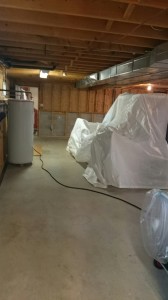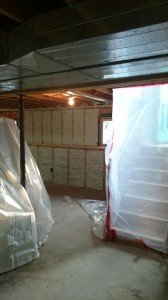September 2014
3″ foam upper, 2″ on concrete blocks




























House Requiring Spray Foam on Exterior and the interior of the roof.











This past weekend we performed our first fireproofing project, there was a little bit of trial and error, but we have got it down pat.
Attached is the product that we use:
www.armourshieldcoatings.com/docs/fireproofing_MonokoteZ3306.pdf
Thanks to McInroy Basement System for letting us help you with your project!
An Excellent Article on Safety:
http://www.canadiancontractor.ca/uncategorized/what-shrapnel-in-home-renovations
Eco-Solutions – HEATLOK SOYA
WORK INCLUDED
• Spray application of polyurethane foam to provide insulation, air barrier and vapour barrier.
QUALITY ASSURANCES
1. Contractor performing work under this section must be licensed under CUFCA (Canadian Urethane Foam Contractors Association) for a minimum of 5 years.
2. Applicators performing work under this section must be trained and certified by CUFCA
3. Upon request of consultant, submit a copy of the contractor quality control report as requested in CAN/ULC-S705.2.
4. Conduct site tests of sprayed work as required by the CUFCA Quality Assurance Program.
5. Upon request of consultant, submit manufacturer/supplier field applied product quality control report.
DELIVERY, STORAGE AND HANDLING
1. Materials shall be delivered in manufacturers original sealed containers clearly labelled with manufacturer’s name, product identification, safety, information, net weight of contents, and expiration date.
2. Material is to be stored in a safe manner and where the temperatures are in the limits specified by the material manufacturer.
3. Empty containers have to be removed from site on a daily basis in accordance with CAN/ULC-S705.2.
APPLICATION CONDITIONS
• Execute the work of this section when the temperature of the air and substrate are within the limits of the data sheet supplied by the manufacturer.
• Apply the spray foam only when the relative humidity is lower than 80%.
• Prepare all surfaces in accordance to manufacturer’s recommendations and
CAN/ULC-S705.2 Standard.
PROTECTION
• Ventilate area receiving insulation to maintain non-toxic unpolluted, safe working conditions.
• Ensure the safety of the workers in conformity with local regulations, standards and manufacturers recommendations.
• For the spraying inside of occupied buildings:
.1 Delimit the working space (with a polyethylene if required).
.2 All the ventilation ducts must be sealed before the spraying.
.3 Install a fan extracting the air outside of the building
.4 The workspace, in retrofit construction (occupied buildings), must be under negative
pressure at a minimum exfiltration rate of 0.3 air changes per hour.
.5 The workspace, in retrofit construction, must be under negative pressure for a minimum of
24 hrs.
.6 Make sure that everyone in the workspace has respiratory protective equipment and a
personal protective equipment in conformity with provincial regulations and the
CAN/ULC-S705.2 standard.
.4 Protect adjacent surfaces, windows, equipment, and site areas from damage of over spray.
WARRANTY.
• Warrant work of this section against defects and deficiencies for a period of two years from date work completion.
• Provide manufacturer warranty for the field-applied product.
PRODUCTS
ENVIRONNEMENTALS REQUIREMENTS
• The product shall not have any CFC or HCFC or any depletion substance affecting the Ozone layer.
• The Spray Polyurethane Foam Insulation shall have a total minimum of 18% recycled content
from post-consummation and post-industrial source. The % shall be calculated by weight
basis ratio of the recycled source in the final SPF system to be applied on the building.
• The SPF shall contain in the formula some renewable vegetable oil content.
• Product shall conform to GREENGUARD certification for children and school.
MATERIALS
• Spray Applied Polyurethane Foam Insulation system in accordance with CAN/ULC S705.1-05 TYPE 2 (Including amendment 1 & 2) Standard for Thermal Insulation Spray Applied Rigid Polyurethane Foam, Medium Density, Material Specification and those specific objectives performances.
• Product: HEATLOK SOYA / POLARFOAM SOYA
• The product shall be evaluated by the NRC for a minimum of 5 years.
EQUIPMENT
• Equipment shall be as recommended in CAN/ULC-S705.2 and approved by foam manufacturer for type of application
EXECUTION
EXAMINATION
• Verify that surfaces and conditions are suitable to accept work as outlined in this section.
• According to the prescriptions of the standard CAN/ULC-S705.2 verify the conditions of surfaces.
.1 Surfaces to be covered with spray foam shall be free of an excess of moisture, frost, oil, rust, and any other foreign material able to have a negative affect on the adhesion of the product.
.2 Make sure of the complete cure of the substrates: concrete, mortar, fillers, membranes, primers, coatings or other surfaces, before pulverizing, taking into account climatic conditions.
.3 If the thickness of application is greater than 50 mm use mechanical fastener to secure self-adhesive membranes around openings (galvanized steel angle: 13 mm x 25 mm x 0.42 mm in thickness (gypsum corner bead). Fixed at 400 mm C/C. ALTERNATIVE: Follow DEMILEC typical details or contact your representative.
• Respect the moisture content of the different building materials.
• In the case of particular conditions follow the recommendations of the manufacturer
• Report in writing, any defects in surfaces or conditions that may adversely affect the performance of products installed under this section to the consultant before commencement of work.
• For occupied building application confirm that all requirements in Article 1.11 are in place.
• Commencement of work outlined in this section shall be deemed as acceptance of existing work and conditions.
APPLICATION
• Spray application of polyurethane foam shall be performed in accordance with CAN/ULC-S705.2. Standard for Thermal Insulation Spray Applied Rigid Polyurethane Foam, Medium Density, Installer’s Responsibilities.
• Apply only when surfaces and environmental conditions are within limits prescribed by the material manufacturer. Refer to technical data sheets.
• Do not spray closer than 3’’ (75 mm) of chimneys, recess spotlight or other source of heat
TOLERANCE
• Apply the product to achieve an average thickness of ± 6mm (1/4’’), from (9 readings in 1 M2), of the thickness requirements
• Apply the insulation uniform in accordance to NBC article 9.25.2.3. 1).
FIRE PROTECTION
• Any open flame or welding that would be in contact with the Spray Polyurethane Foam in place shall be protected as required in CAN / ULC S705.2.
• All plastic insulation must be protected from interior occupancy space by an approved thermal barrier to meet the requirements of local Building Codes.
REFERENCES
1. CAN/ULC-S705.1-05 (Including amendment 1 & 2) TYPE 2, Standard for Thermal Insulation Spray Applied Rigid Polyurethane Foam, Medium Density, Material Specification.
2. CAN/ULC-S705.2-05 Standard for Thermal Insulation Spray Applied Rigid Polyurethane Foam, Medium Density, – Application.
3. Canadian Urethane Foam Contractors Association, (CUFCA)”Manual for Installers of Spray Polyurethane Foam Thermal Insulation”.
4. CUFCA Quality Assurance Program
5. CCMC 13244-L Spray Polyurethane Foam Insulation
6. AIR INS inc. Report AS-00201-A Water Vapour Transmission
7. AIR INS inc. Report A1-02627-A Air Barrier
8. National Building Code for Air Barrier System Properties Art. 5.4.1.2 and A-5.4.1.2
9. GREENGUARD certification for children and school
10. CAN/ULC-S770 Standard Test Method For Determination Of Long-Term Thermal
Resistance Of Closed-Cell Thermal Insulating Foams
I found this article and would like to share it with everyone. I use these three main reasons as well. The main reason I give to customers is the R-Value rating: Heatlok Soya has the highest R-Value when first blown in at 7.2 per inch, and after 5 years it maintains a 6 per inch.
Soundproofing
Insulating your Attic
Preventing Mold
Enjoy the article: http://www.sprayfoam.com/anps/anitem.cfm?annID=2491
| Contractor Gives Alabama Residents Three Important Reasons to Choose Spray Foam Insulation |
| MACON, MS – June 2, 2014 – Spray foam insulation is used by a number of different contractors because of its uncanny ability to effectively insulate any type of structure, and it serves a multitude of purposes. Whether it is domestic or commercial application, spray foam has been proven to be one of the most effective solutions for those who need to keep the elements out of their home in order to conserve energy and remain comfortable. Some of the more common uses of spray foam include:SoundproofingThose who want to ensure that the inside of their home or office is soundproof will definitely be interested in the power of spray foam. This type of insulation is especially effective when it comes to creating a sound barrier, which is just one of the many reasons why it is so incredibly popular. Although soundproofing may not be spray foam’s most common use, it is definitely one of the benefits that those who have it in their home or office enjoy.
Insulating your Attic When spray foam is applied to the ceiling of the attic, it is extremely effective in keeping out seasonal heat and cold year round. A lot of homeowners do not realize just how much of a difference the right kind of insulation in their attic’s ceiling can make. This area of the house is where heat and cold both seep in from outside, which is why it is so important to consider putting spray foam in it. will find that with spray foam insulation in the attic, the home will be a much more comfortable temperature all year round and can save on energy costs. Preventing Mold One of the best uses of spray foam is preventing mold and mildew from becoming a problem. Because spray foam is so effective at minimizing or even eliminating air infiltration and moisture, it is a great way to keep mold from forming in the home. Mold can become a big and expensive problem very quickly, and spray foam can be of great help in guarding against it. When it comes to getting the best foam insulation in Alabama, Dixie Foam LLC is one of the best choices have. The skilled and experienced professionals at this company have been installing spray foam for a number of years and can provide with what need when it comes to insulating the home. About Dixie Foam LLC: Dixie Foam LLC is a spray foam insulation producer and installation company local to Mississippi. The team provides quality insulation for both residential and commercial structures in the area. With great expertise and knowledge, the Dixie Foam team can help better understand the benefits of using spray foam insulation than any other insulating material. Make a difference for the quality, comfort and energy consumption of the structure. |
Welcome to Eco-Solutions Post!
Recent Comments